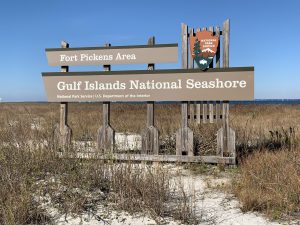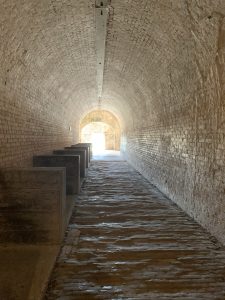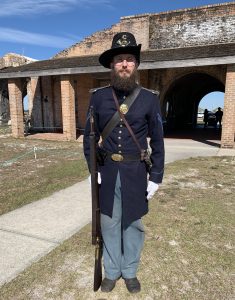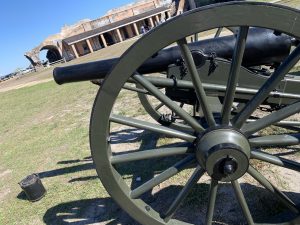
Fort’s re-enactments give lessons in history
PENSACOLA, Fla. — “It was awesome. I ain’t never saw a cannon fire, so I loved it. Shook me up a little bit, though. It was cool. I’d definitely come back here to do it again.”
Kbrain Jones and his friends got an unexpected history lesson when they arrived at Fort Pickens, at the Gulf Islands National Seashore near here to take pictures.
 |
The entrance sign to the Gulf Islands National Seashore, Fort Pickens Area, on Santa Rosa Island (Photos by Pamela Giganti-Bunge). |
“We actually came out to do a photo shoot for an engagement and we ended up bumping into this and we’ll incorporate this into the photo shoot,” he said.
Boom!
The blast from the Civil War era cannon thundered into the crisp air reverberating off the fort’s brick walls, leaving behind a fat plume of white smoke. Even though the crowd expected a loud explosion — ears covered in preparation, it still made many people jump.
Stepping into the pentagon shaped fort that day was like taking a trip back in time. Rangers, interns and volunteers, dressed in Civil War era uniforms, demonstrated how troops shot their muskets and worked as teams to fire cannons as part of an event called School of the Soldier.
The impressive structure with its thick walls of stone and red brick, arched openings and passageways surrounded an expansive grass courtyard. A makeshift teepee, authentic metal cookware, a rustic campfire and other items on display, gave visitors a real sense of what it felt like to serve at the fort during the early days of the republic and during war time.
| The arched passageway inside Fort Pickens. |  |
Fort Pickens is one of five military installations within the Gulf Islands National Seashore, preserved by the National Park Service. It was strategically built at the tip of Santa Rosa Island to defend against maritime invaders.
The Gulf Islands National Seashore spans 160 miles of beautiful, white sandy shoreline and encompasses parts of Mississippi and Florida. It lures visitors with its breathtaking beaches, wildlife, fishing, camping, kayaking, and historic landmarks.
“We’re camping at the campground and we heard about this event, so we came out here because we like learning about history,” said Lora Ann Helms.
She and her family drove down from Charlotte, North Carolina for the Thanksgiving holiday to visit the gulf coast for the first time.
“We like to pick educational trips, so we’re excited this was here,” she said. “We heard the bugle all the way at the campground.”
Chuck Woodhead is a volunteer musician who has been participating in Civil War re-enactments for 20 years as a bugler. The simple brass instrument’s melancholy tones reverberated loudly throughout the fort helping to further anchor the scene’s authenticity.
“I’ve played all up and down the east coast as far as Delaware. I’ve played Taps at Arlington before, and as the principal bugler at Gettysburg multiple times,” Woodhead said proudly.
The colorful re-enactments and live fire demonstrations were an added bonus for the Helms’ family trip.
“We travel a lot just to do history stuff. We homeschool the kids,” said Lora Ann’s husband Nick.
His eight-year-old daughter Lillie quickly chimed in, “It’s cooler to see it, than out of a book.”
Her twin brother Tucker agreed and nodded in approval. When asked what he thought about the cannon blast,
“Cool,” he mused.
Creating a love of U.S. history and the National Park Service is one of the many reasons 32-year-old interpretive ranger Casimer Rosiecki got into this line of work in the first place. He says his interest in the Civil War began as a boy when he read a book about soldiers from Indiana and saw the movie “Gettysburg”.
“There are a few different things to take away when you visit Fort Pickens,” he said.
“One thing it shows us is the extent the U.S. was willing to go to in order to prevent foreign interference in domestic matters.”
After the war of 1812, a series of forts were built to defend strategic waterways. Fort Pickens was constructed to protect the Pensacola Bay area, its harbor and the U.S. Navy yard from invasion. When Florida seceded from the Union and joined the South in January of 1861, Fort Pickens remained in federal control. After the Civil War broke out, the fort was involved in two bombardments with the Confederacy but never surrendered — always remaining in Union hands.
But Ranger Rosiecki says what many visitors may not know is how the fort also played a significant role in black history.
“By 1863, the war changes. Abraham Lincoln’s Emancipation Proclamation went into effect the first day of that year and that would allow the Union army and navy to formally accept free and enslaved black men into military service,” he said.
“Fort Pickens was built by a contractor that relied on enslaved men acting as carpenters, masons and blacksmiths to build all of these walls around us. In 1864, black men returned wearing a blue uniform, not as enslaved men, but as U.S. soldiers.”
 |
Volunteer John Mertins at the fort, dressed in his Civil War era costume. |
John Mertins stood tall bedecked in a replica of one of those blue uniforms as a member of the 3rd United States Infantry, Company C, which was stationed at the fort for about a year. He’s a volunteer with the Walton Guard, a group that helps out with re-enactments at Fort Pickens and other locations around the country.
“It’s a good mix of education on one hand, and kind of entertainment,” he said.
“There’s an aspect of that and you can roll those together. It’s fun to be able to teach people things and you can learn things yourself, being able to pick up those lessons from the past and be able to apply them to modern day living,” Mertins said thoughtfully.
His parents came to see their son in action.
“We’re here watching him. We’re locals, so we love Fort Pickens,” said John’s mother, Mary Mertins.
“When we were younger, we came out here and brought our kids and our family. It’s a special spot for us,” she reflected.
Bedecked in a U.S. artillery shell jacket, cap, wool pants and military style booties called Brogans, National Park Service intern, Michael Dillon Roy walked visitors through the history of a major battle at the fort with ease, emphasizing the ethos of the era with his thoughtful story telling.
“One of the amazing things about this job that I’ve really come to love is — this goes for interns, volunteers, rangers whoever’s doing the interpretation with the public, they don’t give you a script,” Roy said wide-eyed.
| A Civil War era cannon that is used in the firing demonstration at Fort Pickens. |  |
He said the challenge is to find a nugget of information that makes the story more than just show and tell, but relevant and significant.
“It’s one thing if I say, here’s a cannon. Here’s how it works. But if I say, these are the guys that worked that cannon. This is the impact that cannon had on places like Fort Pickens. This is how lives were changed. This is how history was changed. This is the role in a bigger picture this small piece played. I find that hits home with people a lot more,” said Roy.
The 27-year-old from Baton Rouge is working on a master’s degree and aspires to be a park ranger one day. He’s done a great deal of research on the battle he shares with visitors.
“Some historians call it the greatest demonstration of military might in the Pensacola area and I never heard about it until I got here. Many people don’t know the Union held this fort for the entire time of the war,” Roy said.
“That’s why it’s important to remember history and why places are significant like Fort Pickens or Gulf Islands National Seashore or any national park. They are really important to preserve,” he said.
If You Go
- Fort Pickens: 1400 Pickens Road, Pensacola Beach, FL 32561, 850-934-2600.
- Entry to Gulf Islands National Seashore, March – Oct. 31, 5 a.m. – 9 p.m. (last entry 8 p.m.) Nov. 1 – Feb. 28, 5 a.m. – 6 p.m.
- Hours: Fort Pickens: 8 a.m. – sunset, bookstore and Discovery Center: 9 a.m. – 4:30 p.m. Campground registration office, 9 a.m. – 4:30 p.m.
- Entrance fee to Gulf Islands National Seashore: $10 pedestrian, cyclist, $15 motorcycle, $20 per private vehicle with less than 15 passengers, $25 per private vehicle with more than 15 passengers.
- School of the Soldier, Saturday, Sunday from Dec. 8, 2019 – Feb. 29, 2020, 11-11:30 a.m., 3-3:30 p.m. (firing demonstrations dependent on volunteers).
- Check the website for schedule of events, i.e. re-enactments and tours.
- Free maps at the bookstore lead visitors on a self-guided tour through the fort.
- No food or drinks of any kind are sold inside the park. Coolers are allowed.
- Water, sunscreen, hats and comfortable shoes are encouraged.
- Go to www.nps.gov/guis for more information.

Comments are Closed